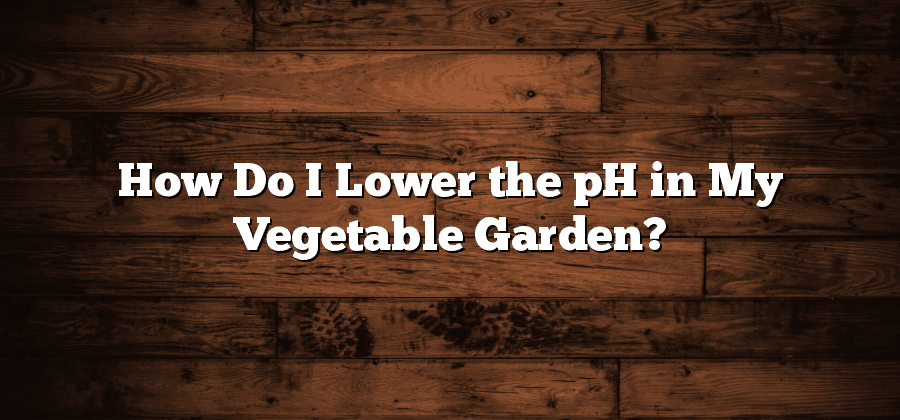Understanding Soil pH Levels in Vegetable Gardens
Soil pH levels play a crucial role in the success of vegetable gardens. pH stands for “potential of hydrogen,” and it measures the acidity or alkalinity of the soil. pH levels are measured on a scale from 0 to 14, with 7 being neutral. pH levels below 7 indicate acidic soil, while levels above 7 indicate alkaline soil.
Understanding the pH levels of your vegetable garden soil is essential because different plants thrive in different pH conditions. For example, most vegetables prefer slightly acidic soil with a pH range of 6 to 6.5. If the pH level is too high or too low, it can lead to nutrient deficiencies, stunted growth, and poor overall plant health. Therefore, testing and monitoring the pH levels of your garden soil is vital for optimal vegetable growth.
Importance of Lowering pH for Healthy Vegetable Growth
To ensure optimal growth and health of your vegetable plants, it is crucial to understand the importance of lowering the pH level in your garden soil. The pH level of the soil directly affects the availability of nutrients to your plants. Most vegetable plants prefer a slightly acidic pH level, typically ranging between 6.0 and 6.5. When the pH level is too high (alkaline), certain essential nutrients, such as nitrogen, phosphorus, and iron, become less available to the plants, leading to nutrient deficiencies and stunted growth.
By lowering the pH level of your soil, you create an environment that promotes the uptake of essential nutrients by the vegetable plants. This allows them to develop robust root systems, generate lush foliage, and produce bountiful harvests. Moreover, maintaining the appropriate pH level helps prevent nutrient imbalances and deficiencies, as well as reduce the risk of pests and diseases that thrive in alkaline conditions. Therefore, understanding and actively managing the pH level of your vegetable garden is a crucial aspect of successful gardening.
Testing the pH Level in Your Vegetable Garden Soil
To ensure healthy vegetable growth in your garden, it is crucial to understand and monitor the pH levels of your soil. Testing the pH level provides valuable information about the acidity or alkalinity of your soil, which in turn affects nutrient availability to plants. The ideal pH range for most vegetable plants is slightly acidic, between 6.0 and 6.8.
There are several ways to test the pH level in your vegetable garden soil. One common method is to use a pH testing kit, which typically includes a soil probe or test strips. Follow the instructions provided with the kit to collect a representative soil sample from your garden. Insert the probe or dip the test strips into the soil, and observe the color change to determine the pH level. Another option is to send a soil sample to a local agricultural extension service or a professional lab for testing. They will provide you with a detailed report, including the pH level and recommendations for adjusting it if necessary. By regularly testing the pH level in your vegetable garden soil, you can make informed decisions about the necessary amendments to achieve optimal plant health.
Natural Ways to Lower the pH in Your Vegetable Garden
One of the key factors for successful vegetable growth in your garden is maintaining the optimal pH level of the soil. When the pH level is too high, it can lead to nutrient deficiencies and hinder the plants’ ability to absorb essential minerals. However, there are several natural ways to lower the pH in your vegetable garden without relying on chemical interventions.
One effective method is to use organic materials that are naturally acidic, such as pine needles, oak leaves, or sawdust. These materials can be mixed into the soil to gradually lower its pH. Another option is to add elemental sulfur, which reacts with soil microbes to produce sulfuric acid and lower the pH. It is important to note that the process of lowering pH through organic materials or elemental sulfur is gradual and may require multiple applications over time. By incorporating these natural methods, you can take control of the acidity levels in your vegetable garden and ensure healthy growth for your plants.
Incorporating Acidic Amendments into Your Garden Soil
Gardeners who want to grow a thriving vegetable garden often find themselves faced with the challenge of adjusting the pH levels in their soil. For some, the solution lies in incorporating acidic amendments into their garden soil. Acidic amendments are substances that can lower the pH of the soil, creating a more optimal environment for vegetable growth.
One popular acidic amendment is elemental sulfur. When added to the soil, elemental sulfur reacts with bacteria and other microorganisms to produce sulfuric acid, which helps to acidify the soil. Another option is pine needles, which naturally contain acids that can lower the pH of the soil. By incorporating these acidic amendments into the garden soil, gardeners can effectively lower the pH levels and create an environment that is more conducive to the healthy growth of their vegetables.






